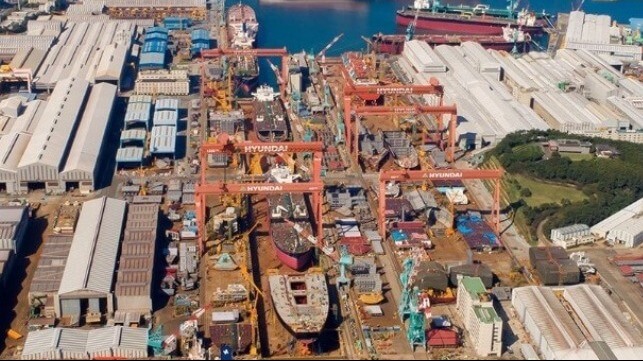South Korea’s Shipbuilders Report Strong February and Outlook

While the global pace of orders for new ships is continuing to slow dramatically from the peak experienced a year ago, South Korea’s shipbuilders are touting their strong start to the year. Analysts agree that the country’s strategy to focus on high-value ships, including LNG carriers as well as emerging technologies for automation and the growing segment for methanol-fueled ships is beginning to show results.
Global orders were off by a quarter in February versus a year ago and down a further two percent off an already weak January. The downward trend started in 2022, with Clarkson Research reporting globally orders were off 22 percent for 2022. January 2023 was dismal for new orders with demand off 63 percent versus a year earlier.
South Korea’s big three shipbuilders, Hyundai, Samsung, and Daewoo, experienced significant declines like all of their competitors in January, but they are reporting a steady and growing pace in the high-value segments on which they are focusing their efforts. The Ministry of Trade, Industry and Energy reported that South Korea received 70 percent of the orders for LNG carriers in 2022, the only segment of the industry recording strong growth. They reported that orders for LNG carriers were up 131 percent in 2022 and that the momentum is carrying forward into 2023.
February was the first time in seven months that South Korea beat its Chinese rivals and received the highest number of orders for new ships. Clarkson reports that the South Korean shipbuilders received 74 percent of the orders last month or 2.1 million compensated gross tons (CGT) or a total of 58 ships. China received just nine percent of global orders in February after dominating the order flow in January with 57 percent of the total, or 72 ships which represented 1.12 million CGTs. South Korea was second with 33 percent of the orders or just 12 ships in January.
China still holds the lead in the overall order backlog with 45 percent of the 100 million CGTs on order as of the end of February. South Korea is second with just under 39 percent of the order backlog. Unlike China, South Korea however was able to grow its backlog by 11 percent in February.
South Korea’s big shipbuilders are reporting that they were able to already book more than a quarter of their yearly order targets. Hyundai for example has already received orders for approximately $6 billion which is nearly 40 percent of its target. Samsung similarly reports orders of $2 billion which is 20 percent of its yearly target. Daewoo is lagging behind so far in 2023, but overall the industry has reached nearly $8.7 billion in orders in 2023.
Clarkson shows slow price increases with less than 10 percent growth per month versus last year. This is despite the increase in raw material costs and labor shortages.
The slow price increases and rising costs lead to large losses for the South Korean shipbuilders. Korean Shipbuilding and Offshore Engineering, for example, reported a loss of more than $27 million in 2022. Daewoo, which was hit by a paralyzing labor strike reported a staggering $1.34 billion loss, which lead to the recapitalization which is currently underway with Hanwha Group acquiring management control of DSME.
The strong order flow in 2023 is continuing to come mostly from higher-priced LNG carriers. Analysts note that the growing orders for dual-fuel methanol ships come with a price tag on average 15 percent higher than traditional ships.
These strengths are leading analysts to forecast according to Business Korea that the South Korean industry will return to profitability in 2023, the first time in eight years. They report that analysts are projecting that KSOE, the parent of Hyundai’s shipbuilding group, could achieve a profit of $771 million in 2023. Even beleaguered DSME reports that half of its backlog, or 62 of the 113 vessels on order, are for higher-priced LNG carriers.
